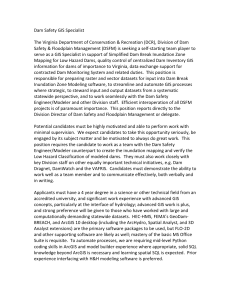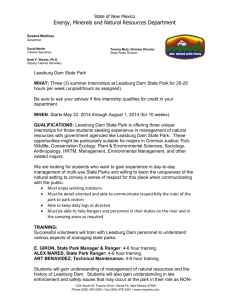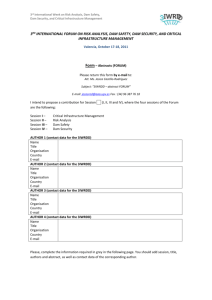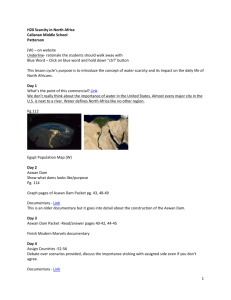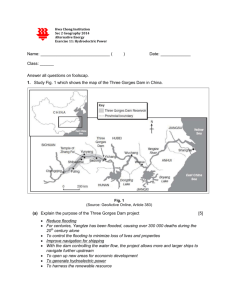Example Planning Scenario - Franklin County Emergency
advertisement
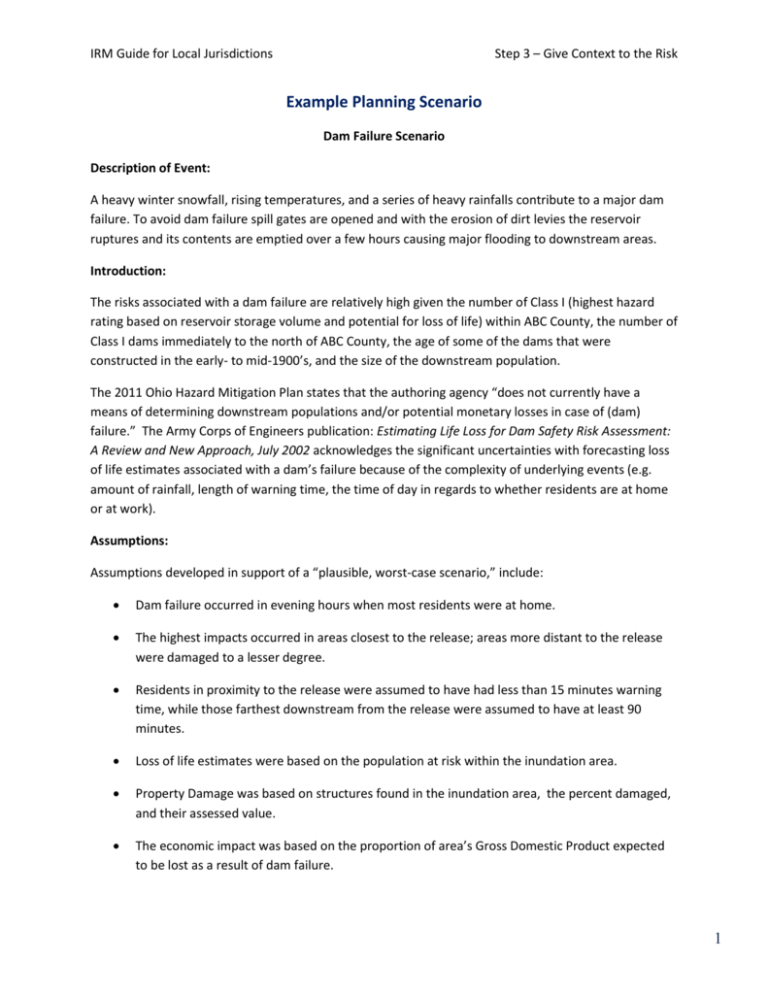
IRM Guide for Local Jurisdictions Step 3 – Give Context to the Risk Example Planning Scenario Dam Failure Scenario Description of Event: A heavy winter snowfall, rising temperatures, and a series of heavy rainfalls contribute to a major dam failure. To avoid dam failure spill gates are opened and with the erosion of dirt levies the reservoir ruptures and its contents are emptied over a few hours causing major flooding to downstream areas. Introduction: The risks associated with a dam failure are relatively high given the number of Class I (highest hazard rating based on reservoir storage volume and potential for loss of life) within ABC County, the number of Class I dams immediately to the north of ABC County, the age of some of the dams that were constructed in the early- to mid-1900’s, and the size of the downstream population. The 2011 Ohio Hazard Mitigation Plan states that the authoring agency “does not currently have a means of determining downstream populations and/or potential monetary losses in case of (dam) failure.” The Army Corps of Engineers publication: Estimating Life Loss for Dam Safety Risk Assessment: A Review and New Approach, July 2002 acknowledges the significant uncertainties with forecasting loss of life estimates associated with a dam’s failure because of the complexity of underlying events (e.g. amount of rainfall, length of warning time, the time of day in regards to whether residents are at home or at work). Assumptions: Assumptions developed in support of a “plausible, worst-case scenario,” include: Dam failure occurred in evening hours when most residents were at home. The highest impacts occurred in areas closest to the release; areas more distant to the release were damaged to a lesser degree. Residents in proximity to the release were assumed to have had less than 15 minutes warning time, while those farthest downstream from the release were assumed to have at least 90 minutes. Loss of life estimates were based on the population at risk within the inundation area. Property Damage was based on structures found in the inundation area, the percent damaged, and their assessed value. The economic impact was based on the proportion of area’s Gross Domestic Product expected to be lost as a result of dam failure. 1 IRM Guide for Local Jurisdictions Step 3 – Give Context to the Risk Probability of Event: Quantifying the probability of dam failure for any one specific dam is difficult given the complexity of underlying conditions that can lead to dam failure and the belief that many dam failures are the result of a chain of events (Army Corp of Engineers). However from Jan. 1, 2005 through Jan. 1, 2009, state dam safety programs reported 132 dam failures and 434 incidents (episodes that, without intervention, would likely have resulted in dam failure). This equates to approximately 140 dam failures/incidents per year in the US, or an overall average of two to three failures/incidents per state annually. Potential Consequences: In general, dam failure is expected to result in a loss of life, extensive property damage, and a diminished local economy. Roads, bridges, telephone lines, power lines, and the dam itself are likely to be damaged as they are commonly found in most inundation areas. Damage, if any, to water and wastewater systems, electrical substations, telecommunication towers, airports, railroads, specific businesses etc. depends on the particular dam that fails and whether these critical infrastructures are located within the failed dam’s inundation area. The reservoirs from three dams in ABC County act as the drinking water source for about 65% of the county. Five collector wells in the southern part of the county provide the other 35%. Despite the inherent redundancy, a loss of any one dam could impact drinking water supplies and, on at least a temporary basis, alternative drinking water sources may need to be identified. The negative consequences associated with the dam failure and the underlying assumptions used in quantifying the magnitude of the consequences are as follows: Loss of Life: Loss of life from dam failures is directly proportional to the population at risk and the percentage of population in their residence at the time of the flood and inversely proportional to the depth and flow of the flood waters and the length of warning time. The calculations for loss of life were based on the formula outlined in the 2011 Department of Homeland Security (DHS) Dam Consequence Estimation - Loss of Life. http://www.damsafety.org/media/Documents/Security/DamsSectorConsequenceEstimationLossofLife.pdf . Specifically with a no warning event, fatalities within the first 3 miles of the inundation zone can be calculated at 0.25 times the population; 3-7 miles equates to 0.08 times the population; and 7-15 miles is 0.01 times the population. These calculations are based on the assumption that the closest population will have the least amount of warning (likely less the 15 minutes). Those within the 3-7 miles can be estimated to have between 15 and 90 minutes of warning time and the population beyond 7 miles of the dam failure would have greater than 90 minutes warning time. 2 IRM Guide for Local Jurisdictions Step 3 – Give Context to the Risk Injuries: The number injured is an indication of the stress placed on local health care systems. The types of injuries that would be expected to occur include: hypothermia from exposure to weather conditions, possible electric shock from downed utility lines, disease from drinking water contaminated with sewage, and slip\fall accidents. In 2010, NOAA reported that in regards to flash floods, the ratio of injuries to fatalities was approximately 3 to 1. Property Damage: Property damage is assumed to be highest near the dam as the force of the flood waters is expected to decrease with an increase in distance from the point of release from the ruptured reservoir. Damage estimates to residential, commercial, public, and agricultural buildings within the inundation area were estimated based on their appraised structural value. Damage to highways, secondary roads, railroads, and power lines were estimated based on their length within the inundation area. A damage estimate was also assumed for critical infrastructures within the inundation area, including structures such as airports, communication towers and lines, water and sanitation treatment plants, electrical substations and the dam itself. Local Economic Impact: Estimating the impact on the local economy often includes an estimation of: property damage, lost jobs, lost wages, reduced profits by affected businesses (direct and indirect), reduced tax revenues, etc. Much of this data was not readily available. Therefore, the local economic impact was based, in large part, on an estimation of the flood’s impact on ABC County’s Gross Domestic Product (GDP). Drinking Water Supplies: An estimate of the temporary need for alternative sources of drinking water is based on the assumption that the dam failed at one of the three primary reservoirs providing drinking water to the county. The assumption is made that given the number of other drinking water sources that one-fifth to one-fourth of the county’s residents may temporarily require an alternative source of drinking water. Geographical Area Impacted: Based on an assumption that one of the Class I dams were to fail and release its entire stored volume of water over a relative short period, the following data regarding the population at risk and assets within the inundated area were provided using the county GIS data. area inundated by flooding: X acres number of households within the inundated area: X households population residing within the inundated area: X population number employed within inundated area: X employees number of commercial parcels in the inundated area: X parcels number of public parcels within the area: X parcels 3 IRM Guide for Local Jurisdictions Step 3 – Give Context to the Risk miles of surface streets within the area: X miles miles of major highways in the area: X miles miles of telephone lines within the area: X miles miles of railroad tracks in the inundated area: X miles miles of high voltage transmission lines within the area: X miles high profile structures within the inundation area include: an airport, water and wastewater treatment plants, and electrical substations. Relevant Core Capabilities: Fatality Management Services Public Health and Medical Services Mass Search & Rescue Mass Care Critical Transportation Operational Communications Public & Private Services and Resources Environmental Response/ Health and Safety On-Scene Security and Protection Situational Assessment Housing Health and Social Services Infrastructure Systems Community Resilience Economic Recovery Threats and Hazard Identification Risk and Disaster Resilience Assessment Long Term Vulnerability Reduction Planning Operational Coordination Public Information and Warning 4




